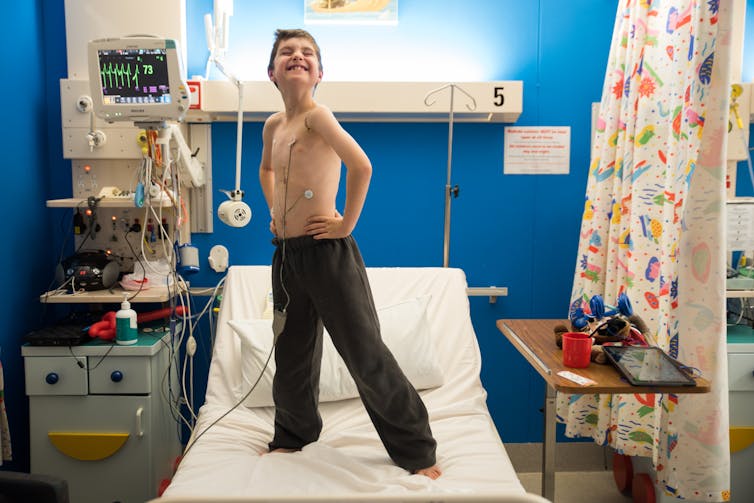Childhood heart disease has a profound impact and is under-recognised
- Written by Nadine Kasparian, Associate Professor of Medical Psychology, UNSW
 Most people assume heart disease is a lifestyle illness that only affects adults. Kylie Kennedy, Author provided
Most people assume heart disease is a lifestyle illness that only affects adults. Kylie Kennedy, Author providedWe are all aware of heart disease in men and women. But childhood heart disease, and its often profound impact on the health and wellbeing of children and their families, is almost invisible.
Every day in Australia, eight babies are born with heart disease, worldwide there are about 1.35 million babies with heart disease each year. Childhood heart disease is fundamentally different from heart disease diagnosed in adult life, which typically occurs as arteries become blocked and heart valves deteriorate with age.
Lifestyle factors often contribute to poor heart health in adulthood, but most childhood heart disease is unrelated to lifestyle. There are many different heart conditions that can occur in childhood, with the main distinction being those present from birth and those that develop during childhood.
Read more: How a simple test could save babies from dying of heart disease
Congenital heart disease
The most common type is congenital heart disease, in which structural abnormalities of the heart are present at birth. This affects one in every 110 newborns and common examples include “holes” in the walls dividing the two sides of the heart, malformed heart valves or chambers, and distortion or obstruction of the main arteries leaving the heart.
 For some children heart disease may be mild, while some require surgery.Kimberley Low, Author provided
For some children heart disease may be mild, while some require surgery.Kimberley Low, Author providedSome children with congenital heart disease have minor abnormalities that never affect their health or need intervention. Others have more complex heart abnormalities that critically impact wellbeing or survival. Many complex forms of congenital heart disease are now identified before birth, when a baby’s heart is just the size of a pea.
Babies and children with complex congenital heart disease require care by highly skilled heart health teams. Sometimes care involves a single but major procedure, usually an open heart operation, while others need a series of operations throughout infancy and childhood. There is a small but real risk of death (7%) and other important complications.
Congenital heart disease is the most common reason babies are admitted to paediatric intensive care. It’s also a leading cause of infant death, and one of the leading causes of disease-related disability in children under the age of five.
The cause of most congenital heart disease is still not known, but we’re increasingly finding genes that play an important role. Medical advances have also resulted in marked improvements in survival, with many more adults now living with complex congenital heart disease.
Read more: Why we don’t know what causes most birth defects
Arrhythmias
Abnormalities of the heart beat (arrhythmias) can occur at any time in life. For some, these occur in childhood, resulting in abnormal and occasionally dangerous variations in heart rhythm.
 Childhood heart disease has a profound impact on wellbeing.The Children’s Hospital at Westmead., Author provided
Childhood heart disease has a profound impact on wellbeing.The Children’s Hospital at Westmead., Author providedFor most children, medication and sometimes cardiac catheterisation (long “wires” inserted in an artery or vein and threaded through the blood vessels to the heart), can offer a “normal” quality of life.
There are rare types of arrhythmia conditions without simple cure and where, even in small babies, pacemakers may be needed to sustain normal heart rate or implantable cardiac defibrillators are used to deliver corrective shocks.
Read more - How Australians Die: cause #1 – heart diseases
Cardiomyopathies
Cardiomyopathies are abnormalities of the heart muscle itself, often occurring in families, and can lead to abnormal heart muscle thickening or weakness. Although the majority of these conditions affect adults, changes in the heart can begin in childhood.
Some conditions can lead to sudden death, with medical and psychological interventions key to providing the best possible protection and preservation of quality of life. In rare cases, a heart transplant in childhood will be needed.
Acquired heart disease
Heart disease may also develop (or be acquired) in childhood. Rheumatic heart disease can occur after selected bacterial (Streptococcal Group A) infections, and Kawasaki disease (caused by inflammation of the blood vessels throughout the body) may impact the circulation of blood in the heart. Muscle damage after certain viral illnesses can reduce the strength of the heart muscle or prevent the heart muscle from functioning properly (such as in myocarditis).
Despite a reducing disease burden worldwide, rheumatic heart disease remains a major challenge in developing countries, and persists in disadvantaged populations in developed countries, where it could be prevented.
Read more: Why are Aboriginal children still dying from rheumatic heart disease?
Where to from here?
As our understanding of the genetics of childhood heart disease advances, so too does our capacity for more accurate prediction of risk, more tailored and personalised treatments, and the potential for prevention, and improved survival and quality of life.
Research is also finding new strategies for best practice medical and psychological care, including interventions to “buffer” young children from the psychological consequences of serious medical illness early in life.
Heart disease is an important childhood illness and for those with more complex conditions, there are implications across all stages of life. Although much progress has been made, we need more research, better transition from paediatric to adult heart health care and greater emphasis on mental health care to minimise the lifelong impact of childhood heart disease.
Nadine Kasparian receives funding from the National Heart Foundation of Australia, the National Health and Medical Research Council (NHMRC), and HeartKids Australia.
David Winlaw receives funding from the National Health and Medical Research Council, HeartKids Australia and previously the National Heart Foundation.
Gary Sholler receives funding from the National Health and Medical Research Council (NHMRC) and HeartKids Australia.
Authors: Nadine Kasparian, Associate Professor of Medical Psychology, UNSW





